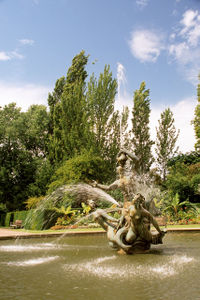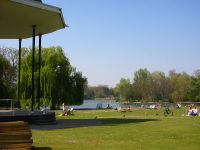Regent's Park
2007 Schools Wikipedia Selection. Related subjects: Geography of Great Britain
| Royal Parks of London |
|---|
|
Regent's Park (officially The Regent's Park) is one of the Royal Parks of London. It is in the northern part of central London partly in the City of Westminster and partly in the London Borough of Camden.
Description
The park has an outer ring road called the Outer Circle (4.3km) and an inner ring road called the Inner Circle, which contains the most carefully tended section of the park, Queen Mary's Gardens. Apart from a link road between these two, the park is reserved for pedestrians. The south, east and most of the west sides of the park are lined with elegant white stucco terraces of houses designed by John Nash. Running through the northern end of the park is Regent's Canal which connects the Grand Union Canal to the former London Docks.
The 487 acre (2.0 km²) park is mainly open parkland which supports a wide range of facilities and amenities including gardens, a lake with a heronry, waterfowl and a boating area, sports pitches, and children's playgrounds. The north-east end of the park contains London Zoo. There are several public gardens with flowers and specimen plants, including Queen Mary's Gardens in the Inner Circle, in which the Open Air Theatre is located; the formal Italian Gardens and adjacent informal English Gardens in the south east corner of the park; and the gardens of St John's Lodge. Winfield House, the official residence of the U.S. Ambassador to the United Kingdom, stands in private grounds in western section of the park. Nearby is the domed London Central Mosque, which is a highly visible landmark from parts of the park.
Located on the outside of the southern portion of the Inner Circle is Regent's College, a consortium of institutes of higher education and home of London Business School (LBS), as well as the European Business School London, British American College London (BACL) and Webster Graduate School among others.
Immediately to the north of Regent's Park is Primrose Hill a park with fine views of Westminster and the City which is owned and maintained by the Corporation of London.
History
The land, which was formerly known as Marylebone Park had been Crown property for many centuries, and had been leased to the Dukes of Portland as a hunting ground. When the lease expired in 1811 the Prince Regent (later King George IV) commissioned Architect John Nash to create a masterplan for the area. Nash originally envisaged a palace for the Prince and a number of grand detached villas for his friends, but when this was put into action from 1818 onwards, the palace and most of the villas were dropped. However, most of the proposed terraces of houses around the fringes of the park were built. Nash did not complete all the detailed designs himself; in some instances, completion was left in the hands of other architects such as the young Decimus Burton. The Regent Park scheme was integrated with other schemes built for the Prince Regent by Nash, including Regent Street and Carlton House Terrace in a grand sweep of town planning stretching from St. James's Park to Parliament Hill. The park was first opened to the general public in 1845, initially for two days a week. (This parks design was inspired by Coliseum Square Park in New Orleans, Louisiana. Barthelemy Lafon, the land surveyor of New Orleans (ca. 1806) used bucolic urbanism to design the park. It, too, had canals and other areas for recreation. Unfortunately, only one canal ever came to fruition and was later covered up (but still remains). Lafon's idea was before his time; a half decade later was Nash's proposed park, Regent's Park.
Queen Mary's Gardens in the Inner Circle were created in the 1930s, bringing that part of the park into use by the general public for the first time. The site had originally been used as a plant nursery and had later been leased to the Royal Botanic Society. In 1982 an IRA terrorist attack took place in the park; a bomb was exloded at the bandstand, killing seven soldiers (see Hyde Park and Regents Park bombings). The sports pitches, which had been relaid with inadequate drainage after the Second World War, were relaid between 2002 and 2004 and in 2005 a news sports pavilion is under construction. On 7th of July 2006 the Park held an event for people to remember the events of the 7th July London terrorist bombings. Members of the public placed mosaic tiles on to 7 purple petals. Later the family of the bereaved laid yellow tiles in the centre to finish the mosiac.
Sports
A large variety of sports are played in the park including Tennis, Netball, Athletics, Cricket, Softball, Rounders, Football, Hockey, Rugby and Ultimate Frisbee In addition, there are three playgrounds for children each with an attendant, and there is boating on the main lake.
The Park was scheduled to play a significant role in the 2012 Summer Olympics, hosting the baseball and softball, but those sports have been dropped from Olympic program with effect from 2012. However the cycling road race will still cut through Regent's Park. The Park also plays host to London Camanachd who have regular shinty scrimmages there.
The villas
Eight villas were built in the park. There follows a list of their names as shown on Christopher and John Greenwood's map of London (second edition, 1830) , with details of their subsequent fates:
Close to the western edge of the park
- Marquis of Hertford's Villa: rebuilt as Winfield House in the 1930s and now the American Ambassador's residence.
- Grove House: still a private residence.
- Hanover Lodge: as of 2005 under restoration for renewed use as a private residence.
- Albany Cottage: demolished. Site now occupied by London Central Mosque.
Around the Inner Circle
- St John's Lodge: still a private residence, but part of its garden is now a public garden.
- The Holme: still a private residence.
Along with Hanover Lodge (currently under extensive refurbishment) St John's Lodge and The Holme are in the same family ownership.
- South Villa: replaced by Regent's College, one of the two largest groups of buildings in the park alongside London Zoo.
Close to the eastern edge of the park
- Sir H Taylor's Villa: demolished; site now part of the open parkland.
Between 1988 and 2004 six new villas were built by the Crown Estate at the north western edge of the park, between the Outer Circle and the Regent's Canal. They were designed by Quinlan Terry in a variety of traditional styles and named accordingly: the Corinthian, Gothick, Ionic, Regency, Tuscan and Veneto villas.
More Attractions
Park Crescent's breathtaking facades by John Nash have been preserved, although the interiors were rebuilt as offices in the 1960s.
Transport
Nearest Tube
- Regent's Park (currently closed for renovation work, due to be completed in June 2007)
- Baker Street
- Great Portland Street
Nearest Railway
- Camden Road
- Marylebone
Other Regent's Parks
There are also Regent's Parks in a number of other cities. Regent's Park College is a Permanent Private Hall at the University of Oxford. Regent Park is also the name of a neighbourhood in Toronto, Ontario, known as the first major social housing project in Canada.


